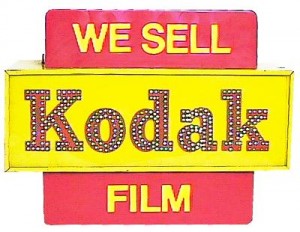[Like all early childhood memories, please consider this story as a possibly flawed recollection. What remains is the learning, for which I’m very grateful.]
I learned about loss leaders on my 5th birthday in 1950. My family-only birthday party (my Mom was very ill and died a year later) was convened at my grandmother’s home. Dad and his brothers owned a small camera shop, Bloom’s Photo Supply, which also sold luggage and umbrellas (but that’s another story).
As the grownups sat around the dining room table, discussing the upcoming Christmas season, Uncle Paul suggested that they reduce dramatically the price of good fresh Kodak film (was there any other? remember the yellow boxes?) in order to draw people into the store. He felt that purchases from the increased traffic would more than make up for any losses on the cost of the film by gathering in the developing business (which was then very high margin) and presenting opportunities to sell those film buyers with (all higher margin) upgraded cameras, camera bags, tripods, and more.
I really don’t remember which brother explained when I asked how they could make money if they “lost” a little on every roll of film. But I think it was my Dad (who ran the selling floor and later added the shipping department) who said that they would make it up on the profit from the other products and services they would sell to those same customers. And they did.
But it’s important to note that there was no attempt to mislead here; they really were selling good fresh film at or below cost. Instead, they were depending on increased traffic (so a greater flow of prospects), salesmanship and buyer psychology to do the rest.
In those simpler, less sophisticated times, when we bought a sealed film package with a clear expiration date on it, we assumed with confidence that the film inside was exactly as advertised and expected. Film was a pretty simple product, the process of buying it was quick and easy, and the very worse that could happen was that our pictures of a major life event would be ruined by outdated or otherwise damaged film. But that was a risk we understood and one that was very very small.
This concept of the loss leader is alive and well today in all things retail, from low-priced airline tickets where the real profit is in all the add-on fees to deeply discounted resort hotel rooms where the real profit is in the expectation of guests’ higher margin eating and drinking on-premise to the sale items you see in every newspaper (yes, there are still actual newspapers) and every manner of electronic discount coupons that increase the volume of customers and prospects who can then be tempted to buy non-sale/non-discount/higher margin items.
But unlike in my memories of Bloom’s Photo Supply, all too often loss leaders aren’t what they seem. All too often, the mirchandise is out-of-date/undesirable/about to expire, the add-on fees are hidden and become gotchas, and the advertised sale goods/services were never intended to be available, which moves us quickly from loss leader to bait and switch.
In much of life, “the house never loses,” something we should all have learned by being lured onto the gaming floor at the casino hotels with the great prices in Vegas where we stayed for the 2011 HR Technology Conference. And this is a lesson we should all remember as we prepare for the 2013 show returning to Vegas.
The use of loss leaders is also alive and well in the business of HR technology. But just as there was nothing dishonest about the use of loss leaders in my Dad’s day, there’s nothing wrong with doing it in our world. But caveat emptor must be our mantra if we’re going to avoid getting flim flammed.
Are you being asked to sign up for HR technology at a price that’s almost too good to be true? With promises of ease of implementation, conservation of the investments you’ve already made, all the benefits of innovation without disruption? What happens when a vendor with a portfolio of so-so products and one really great one uses the really great one to lock you into the portfolio with promises of quantity discounts, ease of integration, shareable support and usage competencies? What happens when what you saw in the demo (shame on you here for not requiring carefully scripted scenario demos) isn’t really delivered in the product and was created for that demo with a good bit of configuration and maybe even a little demo magic?
HR technology is often complex, and the process of buying it must involve considerable research and analysis. Implementations can range from reasonably fast and painless to horrific forced death marches with no end in sight. And what’s at risk is so substantial that we do pilots, go-live drills, parallel testing, and so much more just to be sure that we’re not going to bring our organizations to their knees and/or create a public relations nightmare. There are very large and not always fully understood risks associated with implementing and using HR technology which dwarf any savings we might have gotten on that loss leader.
So when you agree to sign up before the end of the quarter, to pay a lot less for each piece but a lot more for the bundle (when the piece you wanted was terrific but the bundle wasn’t), or to get some new software “for free” in exchange for being a beta customer as long as you keep on paying top dollar for everything else you had purchased from that vendor, ask yourself: “is this a loss leader?” And then ask one more question: “what would Naomi say?”
